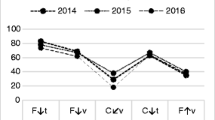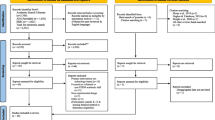Abstract
While research on the understanding of physics concepts in individuals with autism remains scarce, the ever-increasing number of these students in inclusive education nowadays makes their systematic education in all fields of learning necessary. For this purpose, an experimental investigation was conducted to compare 19 autistic adolescents with a matched group of 55 non-autistic adolescents without any identified disability on their alternative ideas. Drawing from constructivist/conceptual change approaches, a computerized instrument was developed to explore participants’ alternative ideas on the concept of force. Autistic adolescents seemed to use the same force models as the comparison group, but with a different frequency. Another interesting finding was the significant difference between the autistic adolescents and the comparison group in terms of the consistency on their most frequently used model. The findings from the present study can inform the design of appropriate instructional interventions to support the conceptual understanding of force in autistic students.













Similar content being viewed by others
Data Availability
Data could be found in the following link: https://www.didaktorika.gr/eadd/handle/10442/42856.
Notes
In the text with the term “autistic,” we refer to those pupils that lie on the high functioning part of the spectrum and used to refer on the handbook of the Diagnostic and Statistical Manual of Mental Disorders (DSM-IV) with the term “Asperger.”.
WISC-III is the third edition of Wechsler Intelligence Scale for Children, an individually administered intelligence test which measures child’s general intellectual ability.
References
Alwan, A. (2011). Misconception of heat and temperature among physics students. Social and Behavioral Sciences, 12, 600–614.
Baron-Cohen, S. (2002). The extreme male brain theory of autism. Trends in Cognitice Sciences, 6(6), 248–254.
Baron-Cohen, S. (2009). Autism: The empathizing – systemizing (E-S) theory. Annual of the New York Academy of Sciences, 1156, 68–80.
Baron-Cohen, S., Wheelwright, S., Spong, A., Scahill, V., & Lawson, J. (2001). Are intuitive physics and intuitive psychology independent? A test with children with Asperger Syndrome. Journal of Developmental and Learning Disorders, 5, 47–78.
Baron-Cohen, S. (1997). Are children with autism superior at folk physics? New Directions for Child and Adolescent Development, 75, 45–54.
Binnie, L., & Williams, J. (2002). Intuitive psychological, physical and biological knowledge in typically developing preschoolers, children with autism and children with down’s syndrome. British Journal of Developmental Psychology, 20, 343–359.
Brigham, F. J., Scruggs, T. E., & Mstropieri, M. A. (2011). Science education and students with learning disabilities. Learning Disabilities Research and Practice, 26(4), 223–232.
Cavinez, G. L. (2013) Psychometric versus actuarial interpretation of intelligence and related aptitude batteries. In D. H. Saklofske, V. L. Schwean, & C. R. Reynolds (Eds.), The Oxford handbook of child psychological assessment (pp. 84–112). Oxford University Press.
Cheng, M. F., Wu, T. Y., & Lin, S. F. (2021). Investigating the relationship between views of scientific models and modeling practice. Research in Science Education, 51(suppl 1), S307–S323.
Cihak, D. (2011). Comparing pictorial and video modeling activity schedules during transitions for students with autism spectrum disorders. Research in Autism Spectrum Disorders, 5, 433–441.
Clark, D., D’Angelo, C., & Schleigh, S. (2011). Comparison of students’ knowledge structure coherence and understanding of force in the Philippines, Turkey, China, Mexico and the United States. The Journal of the Learning Sciences, 20, 207–261.
Clark, D., Menekse, M., Ozdemir, G., D’Angelo, C., & Schleigh, S. (2014). Exploring sources of variation in studies of knowledge structure coherence: Comparing force meanings and force meaning consistency across two Turkish cities. Science Education, 98(1), 143–181.
diSessa, A., Gillespie, N., & Esterly, J. (2004). Coherence versus fragmentation in the development of the concept of force. Cognitive Science, 28, 843–900.
Driver, R., Guesne, E., & Tiberghien, A. (1985). Children’s ideas in science. Open University Press.
Field, A. (2018). Discovering statistics using IBM SPSS statistics (5th ed.). SAGE.
Fombonne, E. (1999). The epidemiology of autism: A review. Psychological Medicine, 29, 769–787.
Groen, Y., Fuermaier, A., Heijer, D., Tucha, O., & Althaus, M. (2015). The empathy and systemizing quotient: The psychometric properties of the Dutch version and a review of cross-cultural stability. Journal of Autism and Developmental Disorders, 45(9), 2848–2864.
Hewitt, P. G. (2014). Conceptual Physics. Pearson Education.
Ioannides, C., & Vosniadou, C. (2002). The changing meanings of force. Cognitive Science Quarterly, 2(1), 5–62.
Jimoyiannis, A., & Komis, V. (2003). Investigating Greek students’ ideas about forces and motion. Research in Science Education, 33, 375–392.
Kaliampos, G., Ravanis, K., & Vavougios, D. (2021). A comparison study of alternative conceptions on impetus theory and projectile motion of adolescents with typical development and high functioning autism spectrum disorder. International Journal of Science Education, 43(1), 128–156.
Kaliampos, G., Verevi, A., Panagopoulou, A., Papalexopoulos, P., & Vavougios, D. (2017). Designing a database of research papers focused on teaching Science to studenst with Learning Disabilities. Asian Journal of Education and e-Learning, 5(3), 95–102.
Kambouri-Danos, M., Ravanis, K., Jameau, A., & Boilevin, J.-M. (2019). Precursor modelsand early years Science learning: A case study related to the mater state changes. Early Childhood Education Journal, 47(4), 475–488.
Krajmer, P., Janosikova, D., Spajdel, M., & Ostatnikova, D. (2010). Empathizing, systemizing, intuitive physics and folk psychology in boys with asperger syndrome. Activitas Nervosa Superior Rediviva, 52(1), 57–61.
Lawson, J., Baron-Cohen, S., & Wheelwright, S. (2004). Empathizing and systemizing in adults with and without Asperger syndrome. Journal of Autism and Developmental Disorders, 34(3), 301–310.
Lemmer, M., Kriek, J., & Erasmus, B. (2020). Analysis of students’ conceptions of basic magnetism from a complex systems perspective. Research in Science Education, 50, 375–392.
Leslie, A., & Keeble, S. (1987). Do six-month old infants perceive causality? Cognition, 25, 265–288.
Ministrell, J. (1982). Explaining the “at rest” condition of an object. The Physics Teacher, 20(1), 10–14.
National Center for Education Statistics. (2019). Elementary and Secondary Education (Chapter 2). In Digest of Education Statistics 2017 (pp. 65–378). Institute of Education Sciences, U.S. Department of Education.
Osborne, R., & Freyberg, P. (1985). Learning in science: The implications of childrens’science. Heinema.
Ozdemir, G., & Clark, D. (2009). Knowledge structure coherence in Turkish students’ understanding of force. Journal of Research in Science Teaching, 46(5), 570–596.
Paganini, C., & Gaido, D. (2013). Perception in autism: An interactive global research between folk psychology and folk physics. Journal of Social Evolutionary and Cultural Psychology, 7(2), 175–195.
Ravanis, K., Kaliampos, G., & Pantidos, P. (2021). Preschool children sciencemental representations: the sound in space. Education Sciences, 11(5), 242.
Raven, J., Raven, J. C., & Court, J. H. (2003). Standard progressive matrices sets A, B, C, D & E (2000th ed.). Pearson.
Shah, A., & Frith, U. (1993). Why do autistic individuals show superior performance on the block design task? Journal of Child Psychology and Psychiatry, 34(8), 1351–1364.
Subiaul, F., Rutherford, M., Lopez-Duran, S., & Povinelli, D. (2004). Do children with autism have an explanatory drive? The George Washington University, USA.
Van de Cruys, S., Evers, K., Van der Hallen, R., Van Eylen, L., Boets, B., de-Wit, L., & Wagemans, J. (2014). Precise minds in uncertain worlds: Predictive coding in autism. Psychological Review, 121(4), 649–675.
Viennot, L. (1979). Spontaneous reasoning in elementary dynamics. European Journal of Science Education, 1(2), 205–225.
Watts, M. (1983). A study of schoolchildren’s alternative frameworks of the concept of force. European Journal of Science Education, 5(2), 217–230.
Author information
Authors and Affiliations
Corresponding author
Ethics declarations
Conflict of Interest
The authors declare no competing interests.
Additional information
Publisher's Note
Springer Nature remains neutral with regard to jurisdictional claims in published maps and institutional affiliations.
Rights and permissions
Springer Nature or its licensor (e.g. a society or other partner) holds exclusive rights to this article under a publishing agreement with the author(s) or other rightsholder(s); author self-archiving of the accepted manuscript version of this article is solely governed by the terms of such publishing agreement and applicable law.
About this article
Cite this article
Kaliampos, G., Mavropoulou, S., Kollias, V. et al. An Experimental Investigation of Alternative Ideas of Force in Autistic Adolescents. Res Sci Educ 53, 867–888 (2023). https://doi.org/10.1007/s11165-023-10115-8
Accepted:
Published:
Issue Date:
DOI: https://doi.org/10.1007/s11165-023-10115-8




